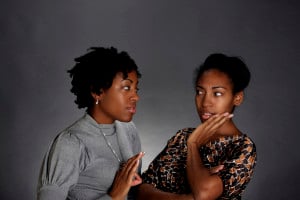
A person wearing a plaid shirt and dark-rimmed glasses smiles into the camera.
Once upon a time, the term asexual served the purpose of covering anyone and everyone who didn’t feel so inclined to marry, to romance, to fuck. Homosexual, heterosexual, and asexual were the only labels worth mentioning, and covered all necessary categories.
Or so we thought.
And then along came my fabulous and ridiculously queer self, balancing on that liminal edge beyond which more precise, more nebulous, and more complicated labels lay – and I’m not the only one.
Though I’d always known I didn’t find the relationship escalator inevitable, though I was more disgusted by romance than by sex, and though I found intimate friendships more desirable than couple pairings, I found myself puzzled by the way “asexual” didn’t fully describe my experiences.
But then along came those pesky bisexual and pansexual folk to remind everyone that actually, no, it wasn’t that simple or easy.
And then, I finally found the term through which all of my other identities fully crystallized: aromantic.
See, people had been calling me cold, weird, distant, and pretty much every synonym for “unloving” that could possibly exist. This made little sense to me. I felt so much, so incredibly deeply. I simply didn’t express it like others did. I didn’t define my relationships by hierarchy or escalation but by the ways we grew alongside one another, the ways our minds and emotions entwined yet never merged.
Needless to say, my noetisexual self dove deep into the murky waters of the asexual community to uncover the treasures hidden along the silted bottom. The aromantic experience and identity lay there waiting, through a tunnel leading into new waters, new territory – connected and yet distinct.
How Sex Became Separated From Romance
Once there, a hidden history was revealed, one that wasn’t so neat and tidy for the more assimilationist of the Gay Rights Movement™ (white, cis, gay men, mostly).
New terms sprouted to describe more liminal and varied experiences. Non-binary people marked out their space, pansexual people sought to better accommodate them, and the forgotten letters in the alphabet soup battled for their territory.
I soaked it up with abandon, devouring new terms like I was dying of thirst. I edged ever closer to that long list of terms that would fully describe my various aspects.
There were many firefights. Many splits throughout the decades. As bisexual and pansexual people argued and as transgender and gender non-conforming people wondered if they really were under the same umbrella, the asexual folks began to quietly gather in the background and build momentum.
As the conversation became more nuanced, as any human endeavor is wont to do, new scales of measure burst forth into creation. Many asexual people wanted to stress the fact that they still wanted to do everything other couples did, except in some cases they’d simply choose to be celibate.
Perhaps it was simply a way for asexual people to still remain attached to the larger queer movement, which for a long while, and sometimes still now, says “We’re just like you! See? We want the same things you want” to the straight majority.
Or perhaps it was to do with the concurrent rise of polyamory and other forms of non-monogamy among straight cis people (that is, the mainstream), in which many discovered by surprise that there existed alternate, but equally impactful forms of bonding with each other beyond the sexual or even the romantic.
Whatever the reason, sexuality was now separate from romance for all intents and purposes.
And I rejoiced.
How Aromantic Became Its Own Identity
Enter the aromantic (aro for short).
Some aces (shorthand for asexual) categorically opposed anything mirroring marriage, romance, or the relationship escalator that often accompanied coupledom. Some people, regardless of their sexual orientation, simply never fell in love. In fact, some of them were even repulsed by the very idea of romantic love.
I am one such ace.
For whatever reason, many folks woke up to the fact that we weren’t broken or cold or emotionless – we were simply misunderstood, as many others in the LGBTQIA+ community are.
Even though the term aromantic first came up in asexual discourse, it soon spread and was adopted by aces, allosexuals (people who are sexually attracted to others), autistics, and many others – myself included (as everything but allosexual).
It came to represent all those who, for whatever reason, never or very rarely feel romantic attraction, don’t want romantic relationships, or prefer friendship to romance.
Finally, I had available a descriptor that better allowed me to define what it is I was seeking to build with people. Where before I only had words bound up with romantic overtones, I found and created terms more closely related to friendship than romance – queerplatonic, sensual attraction, noetisexual, aesthetic attraction, squish, and so on.
Suddenly my dreams of living in a big house with all of my closest friends (whether sexual or not) was grounded in possible reality rather than fantasy! My many years of loneliness and the misunderstandings that arose when someone claimed I didn’t love them came into stark focus.
It wasn’t that I was defective, it wasn’t that I didn’t feel love, it wasn’t that I was incapable of forming close attachments. It’s simply that romance was something I’d never felt or could feel.
But even as I celebrated, I began to see a split occur. As a sex-neutral ace, I felt alienated from celibate aces. And as an aro ace, I soon found myself being thrown under the bus – all in the name of love.
The Variation of Identities
While there is some overlap between the ace and aro communities, they’re actually separate and distinct. For instance, even though I happen to be both an ace and aro, I find I have more in common with other aros than with other aces.
I found that there are other aces who still want to marry, still value romance over friendship, and still buy into harmful amatonormative ideals. Aros, though, tend to eschew the rituals of courtship, the escalation of romantic relationships, and are a bit more anarchic when it comes to the formation and intensity of each relationship.
Beyond that, aros can typically be of any sexuality in the rainbow, and have much more in common with the roots of the queer movement than aces do.
The “gay” rights movement was largely anarchic, queer as hell, Black-run, and trans-led in origin. It wasn’t until later on that romance – in the more traditional model of relationship escalator, marriage, and children – came into the picture in an effort to make queer “lifestyles” more palatable.
People like me were left adrift. We traversed the very edges of the ace community, not ever really fitting in. Many aces denied us, using the fact that they still desired romance to show that they were “just like romantic people” – not like those weird aros who felt nothing!
Unfortunately, aces of various romantic orientations still aren’t often acknowledged in the alphabet soup, and are often left behind in supposedly “sex-positive” discussions and places.
And because the nuanced differences aren’t well-understood by allosexual alloromantic folk – for whom sex and romance tend to be very strongly linked, or at least assumed to be – aces and aros are still commonly conflated and summarily dismissed.
Examples of Available Relationship Types for Each (And How They Differ)
Worse yet, the types of relationships we desire and are even capable of are frequently confused, causing unnecessary frustration and heartache.
Someone who is aro will only very rarely get married for romantic reasons. An ace may avoid marriage, but mostly due to assumptions about sex being necessary. For the most part, romance, marriage, and kids are still on the agenda for many aces of any orientation.
For many aros, however, friendship often can be and is the tiptop of the pyramid, not romantic entanglement. Aros may tend to identify as perma-single, solo polyamorous, relationship anarchists, ethical sluts, relationship fluid, or some other such thing (or all of them, in my case).
While queerplatonic or companionate relationships are available options to both aces and aros, the practicalities of it vary. An ace may still tend to choose someone they’re romantically attracted to, whereas an aro may choose a sensual partner, an emotional bond, a family member, or really anyone they trust – independent of who they may be attracted to, in any sense of the word.
Friendship is inherently non-monogamous in nature, and so many aros (myself included) are often befuddled by common romantic practices surrounding behaviors, restrictions, and fencing status or assumptions.
In my own life, I know my aromanticism has cost me dear friendships, as others left me for romantic partners, sexual partners, or because they wanted something from me that I could never give.
For many aces, the puzzlement often simply lies in why people assume sex needs to be involved in pretty much everything!
These different approaches and issues arise in their own unique ways for each community, and that’s important because these distinctions have their own implications.
Why the Differences Between Aros and Aces Matter
Aros want different things than aces, and something that makes one happy would be devastating for another. For myself, my aromanticism has a much larger effect and deeper implications on the course of my life than my asexuality.
Additionally, the risk for harm in each type of relationship differs. While both aces and aros tend to get passed over for sexual-romantic partners, romantic aces still have a much larger pool of potential partners to choose from. Though being “best friends forever” is something to aspire to in childhood, there aren’t many alloromantic adults that will actually take it very seriously.
While both aces and aros may face the threat of sexual violence, for aces, it’s more about someone trying to “correct” us or misreading our signals. For aros, it can be born of sex-shaming, or the assumption that one is “easy,” or even due to a lover spurned by the lack of reciprocal romantic feelings.
Both aros and aces face similar challenges, as does anyone in the LGBTQIA+ community. But to treat them as one and the same will inevitably end up doing the same damage that’s been done to many others already in the queer community. It will still lead to erasure, and all for the sake of conformity that none of us asked for.
***
Knowledge about these differences can help for clarifying relationship needs, bringing up new possibilities and better choices for relationship formation, and for turning friendship into something more than a simple throwaway stand-in for some potential romantic partner.
Having all of these new and unique labels may seem really confusing or unnecessary, but understanding what they mean and what they represent can help give you a peek into experiences and perspectives you haven’t yet considered, that are equally as valid as anyone else’s, and that deserve the same recognition and support as everyone else’s.
[do_widget id=’text-101′]
Michón Neal has so many identities they won’t fit here. Ze writes a mix of scifi, fantasy, erotica, and autobiography called cuil fiction about unique people in unique circumstances, with characters running the gamut of non-monogamous and LGBTQIA+ spectrums. That’s right: queer and poly fiction! Ze is currently working on the Cuil Effect project, a ridiculously long tale about healing, absurdity, and all the different ways people interact. You can find more details, sneak peaks, links, and absurdity on hir blog, Shadow in the Mirror. Ze also invented the only class on Intersectional Non-Monogamy and is the co-editor for Postmodern Woman.
Search our 3000+ articles!
Read our articles about:
Our online racial justice training
Used by hundreds of universities, non-profits, and businesses.
Click to learn more




















